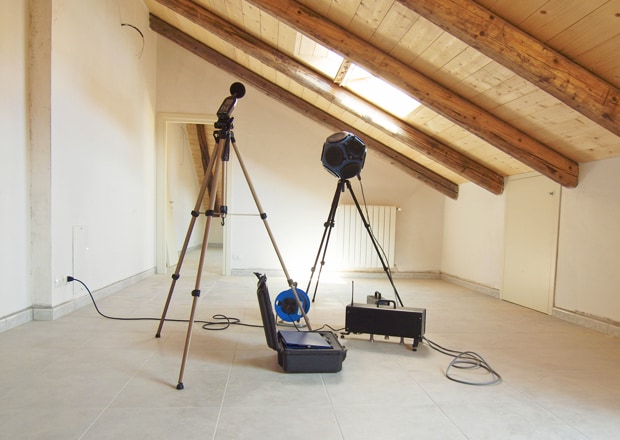Data Acquisition (DAQ)
Sound Intensity Measurement
-
Tags:
- Sound Intensity , Sound Level

Traditionally, sound intensity was measured using two microphones at specific locations, facing limitations like planar surface issues and the need for careful probe placement. However, technological advancements, such as the KEYENCE Multi-input Data Loggers, now offer more accurate and efficient sound intensity measurement techniques.
We’re here to provide you with more details.
Reach out today!

What is Sound Intensity?
Sound intensity is a fundamental characteristic of acoustics that shapes the world's perception. It measures the acoustic energy transmitted by sound waves as they travel through a medium and serves as a metric for loudness. Sound intensity can be assessed with another sound of the same frequency by calculating the ratio of their powers. This method takes into account both the amplitude and frequency components of sound, offering a comprehensive understanding of their relationship.
How to Measure Sound Intensity?
An audiometer is a device designed to assess an individual's ability to hear distinct sounds. Unlike conventional measurement units, decibels operate on a logarithmic scale, meaning variations occur exponentially rather than in uniform increments, resulting in a unique methodology for measuring noise intensity.
For example, a sound intensity of 20 dB is actually one hundred times louder than 10 dB, not just twice as loud. Similarly, an increase from 50 dB to 60 dB means the sound is ten times more intense.
To measure noise intensity in decibels, you need two pieces of information: the reference value and the actual value. The reference value is usually the lowest level audible to humans, approximately 0.00002 pascals or 0 dB, serving as a baseline for other measurements.
Once the reference value is established, a sound level meter can accurately measure a source's sound level in decibels. These meters use a microphone to capture sound waves and convert them into electrical signals, which are then amplified, filtered, and displayed on a decibel scale.
Discover more about this product.
Click here to book your demo.

Units of Sound Intensity Measurement
The decibel (dB), a unit of sound intensity, is one-tenth of a bel. Introduced by Alexander Graham Bell in the late 19th century to measure telegraph signals, the decibel scale was later adapted for sound measurement. Its logarithmic structure allows for a wide range of values to be expressed on a manageable scale, enhancing clarity and comprehension.
Applications of Sound Intensity Measurement
Measuring sound intensity is crucial in various fields and industries. It quantifies not just the loudness of sound but also its direction and location. Accurately assessing sound intensity affects many applications that significantly affect our daily lives:
- Environmental Noise Monitoring: A key application of sound intensity measurement is monitoring environmental noise. This involves assessing noise from human activities like road traffic, construction, and industrial operations. Using sound intensity meters, scientists and engineers can evaluate the impact of these activities on the environment.

- Building Acoustics: Measuring noise intensity is vital in building acoustics, as it assesses sound transmission within structures—from external sources to indoor spaces and between rooms. This information is vital for designing buildings that achieve optimal sound insulation and acoustic comfort.
- Automotive Industry: These measurements are crucial for evaluating noise control strategies in the automotive industry, such as engine and exhaust insulation, and for ensuring compliance with noise regulations in various countries.
KEYENCE DAQ Systems for Sound Intensity Measurement
Accurate sound intensity measurement requires specialized equipment like data acquisition (DAQ) systems. The NR-X Series DAQ systems excel in managing multiple sound data channels, offering precise real-time measurements with exceptional sensitivity and accuracy, even in complex environments.
The NR-X Series is designed for compactness and lightweight functionality, enhancing usability in various environments. Its palm-sized design ensures portability and convenience for on-site measurements. Additionally, the system supports up to 576 channels for multi-channel measurement, offering users flexibility and efficiency in data collection. This feature is especially valuable for large-scale experiments or production lines that require simultaneous sound intensity measurements.
With an intuitive interface and an advanced data management system, the included software simplifies the setup and operation of the DAQ system, making it accessible for users without extensive technical expertise. It also provides various analytical functions for detailed insights into sound intensity measurements, such as real-time frequency analysis and time-series evaluation, enhancing the understanding of recorded sound data.
Upgrade your sound intensity measurement capabilities with the KEYENCE NR-X Series DAQ systems and contact us today!
Contact us to learn more about how our advanced technology can help take your business to the next level.
Contact Us



